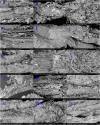Datura quids at Pinwheel Cave, California, provide unambiguous confirmation of the ingestion of hallucinogens at a rock art site
- PMID: 33229522
- PMCID: PMC7733795
- DOI: 10.1073/pnas.2014529117
Datura quids at Pinwheel Cave, California, provide unambiguous confirmation of the ingestion of hallucinogens at a rock art site
Abstract
While debates have raged over the relationship between trance and rock art, unambiguous evidence of the consumption of hallucinogens has not been reported from any rock art site in the world. A painting possibly representing the flowers of Datura on the ceiling of a Californian rock art site called Pinwheel Cave was discovered alongside fibrous quids in the same ceiling. Even though Native Californians are historically documented to have used Datura to enter trance states, little evidence exists to associate it with rock art. A multianalytical approach to the rock art, the quids, and the archaeological context of this site was undertaken. Liquid chromatography-mass spectrometry (LC-MS) results found hallucinogenic alkaloids scopolamine and atropine in the quids, while scanning electron microscope analysis confirms most to be Datura wrightii Three-dimensional (3D) analyses of the quids indicate the quids were likely masticated and thus consumed in the cave under the paintings. Archaeological evidence and chronological dating shows the site was well utilized as a temporary residence for a range of activities from Late Prehistory through Colonial Periods. This indicates that Datura was ingested in the cave and that the rock painting represents the plant itself, serving to codify communal rituals involving this powerful entheogen. These results confirm the use of hallucinogens at a rock art site while calling into question previous assumptions concerning trance and rock art imagery.
Keywords: Datura; Native California; hallucinogens; quids; rock art.
Copyright © 2020 the Author(s). Published by PNAS.
Conflict of interest statement
The authors declare no competing interest.
Figures






References
-
- Lewis-Williams J. D., et al. , The signs of all times: Entoptic phenomena in Upper Palaeolithic art. Current Anth. 29, 201–245 (1988).
-
- Bahn P., Prehistoric Rock Art: Polemics and Progress (Cambridge University Press, 2010).
-
- Helvenston P., Bahn P., Yes, there is a ‘shamanism and rock art debate.’ Before Farming 2007, 1–6 (2007).
-
- Helvenston P., Bahn P., Bradshaw J., Chippidale C., Testing the ‘three stages of trance’ model. Camb. Archaeol. J. 13, 213–224 (2003).
-
- Dowson T., Debating shamanism in Southern African rock art: Time to move on. S. Afr. Archaeol. Bull. 62, 49–61 (2007).
Publication types
MeSH terms
Substances
LinkOut - more resources
Full Text Sources

